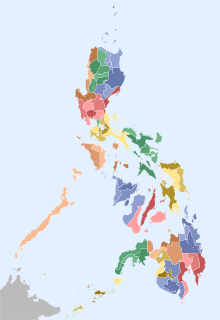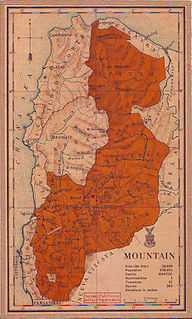
The provinces of the Philippines are the primary political and administrative divisions of the Philippines. There are 81 provinces at present, further subdivided into component cities and municipalities. The local government units in the National Capital Region, as well as independent cities, are independent of any provincial government. Each province is governed by an elected legislature called the Sangguniang Panlalawigan and by an elected governor.

Cordillera Administrative Region, designated as CAR, is an administrative region in the Philippines, situated within the island of Luzon. The only landlocked region in the insular country, it is bordered by the Ilocos Region to west and southwest, and by the Cagayan Valley Region to the north, east, and southeast. Prior to the 2015 census, it was the least populated and least densely-populated region in the country.
The legislative district of Abra is the representation of the province of Abra in the various national legislatures of the Philippines. The province is currently represented in the lower house of the Congress of the Philippines through its lone congressional district.
The legislative districts of Agusan del Sur are the representations of the province of Agusan del Sur in the various national legislatures of the Philippines. The province is currently represented in the lower house of the Congress of the Philippines through its first and second congressional districts.
The legislative district of Apayao is the representation of the province of Apayao in the various national legislatures of the Philippines. The province is currently represented in the lower house of the Congress of the Philippines through its lone congressional district.
The legislative district of Kalinga is the representation of the province of Kalinga in the various national legislatures of the Philippines. The province is currently represented in the lower house of the Congress of the Philippines through its lone congressional district.
The legislative district of Baguio is the representation of the highly urbanized city of Baguio in the various national legislatures of the Philippines. The city is currently represented in the lower house of the Congress of the Philippines through its lone congressional district.
The legislative district of Basilan is the representation of the province of Basilan in the various national legislatures of the Philippines. The province is currently represented in the lower house of the Congress of the Philippines through its lone congressional district.
The legislative district of Benguet is the representation of the province of Benguet in the various national legislatures of the Philippines. The province is currently represented in the lower house of the Congress of the Philippines through its lone congressional district.
The legislative district of Ifugao is the representation of the province of Ifugao in the various national legislatures of the Philippines. The province is currently represented in the lower house of the Congress of the Philippines through its lone congressional district.
The legislative district of Camiguin is the representation of the province of Camiguin in the various national legislatures of the Philippines. The province is currently represented in the lower house of the Congress of the Philippines through its lone congressional district.
The legislative district of Mountain Province is the representation of Mountain Province in the various national legislatures of the Philippines. The province is currently represented in the lower house of the Congress of the Philippines through its lone congressional district.
The legislative district of Iligan is the representation of the highly urbanized city of Iligan in the Congress of the Philippines. The city is currently represented in the lower house of the Congress through its lone congressional district.
The legislative districts of Zamboanga del Sur are the representations of the province of Zamboanga del Sur in the various national legislatures of the Philippines. The province is currently represented in the lower house of the Congress of the Philippines through its first and second congressional districts.
The legislative district of Davao del Sur is the representation of the province of Davao del Sur in the various national legislatures of the Philippines. The province is currently represented in the lower house of the Congress of the Philippines through its lone congressional district.
The legislative districts of South Cotabato are the representations of the province of South Cotabato and the highly urbanized city of General Santos in the various national legislatures of the Philippines. The province is currently represented in the lower house of the Congress of the Philippines through its first and second congressional districts.

The legislative districts of Sultan Kudarat are the representations of the province of Sultan Kudarat in the various national legislatures of the Philippines. The province is currently represented in the lower house of the Congress of the Philippines through its first and second congressional districts.
The legislative districts of Lanao del Norte are the representations of the province of Lanao del Norte in the various national legislatures of the Philippines. The province is currently represented in the lower house of the Congress of the Philippines through its first and second congressional districts.
The legislative district of Occidental Mindoro is the representation of the province of Occidental Mindoro in the various national legislatures of the Philippines. The province is currently represented in the lower house of the Congress of the Philippines through its lone congressional district.

The sub-provinces of the Philippines were a political and administrative division of the Philippines. The sub-provinces were a part of a larger "regular" province and residents of a sub-province participated in provincial elections of the parent province.




